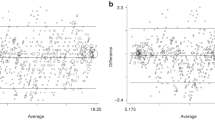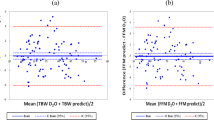Abstract
Background/objectives:
Despite the utmost importance of body height in evaluating nutritional status, it is not always possible to obtain its measurement and height may have to be estimated. The objective of the study was to formulate and cross-validate a regression equation to predict height using hand length measurement and also to determine if predicted height (PH) will lead to significant errors when used in body mass index (BMI) calculation.
Subjects/methods:
A cross-sectional study was conducted using a consecutive sample of 465 inpatients (19–91 years), from a university hospital. Participants were randomly divided into a development sample of 311 individuals and a cross-validation one. A linear regression model was used to formulate the equation. Intraclass correlation coefficients (ICCs) for single measures and differences between measured height (MH) and PH and between BMI calculated with MH (BMIMH) and with PH (BMIPH) were determined.
Results:
The regression equation for PH is: PH (cm)=80.400+5.122 × hand length (cm)—0.195 × age (years)+6.383 × gender (gender: women 0, men 1) (R=0.87, s.e. of the estimate=4.98 cm). MH and PH were strongly correlated, ICCs: 0.67-0.74 (P<0.001). Differences were small, mean difference±s.d., ⩽−0.6±4.4 cm (P⩾0.24). BMIMH and BMIPH were strongly correlated, ICCs: 0.94-0.96 (P<0.001). Differences were small, ⩽0.3±1.7 kg/m2 (P⩾0.10).
Conclusions:
The formulated regression equation using hand length, age and gender provides a valid estimation of height and is useful in the clinical context. PH from this regression equation can be used in BMI calculations as misclassification is small.
This is a preview of subscription content, access via your institution
Access options
Subscribe to this journal
Receive 12 print issues and online access
$259.00 per year
only $21.58 per issue
Buy this article
- Purchase on Springer Link
- Instant access to full article PDF
Prices may be subject to local taxes which are calculated during checkout


Similar content being viewed by others
References
Lee RD, Nieman DC . Assessment of the hospitalized patient. In: Lee RD, Nieman DC (eds) Nutritional Assessment 4th edn Mosby: Chicago, IL, 2007, pp 226–231.
Hickson M, Frost G . A comparison of three methods for estimating height in the acutely ill elderly population. J Hum Nutr Diet 2003; 16: 13–20.
Brown JK, Whittemore KT, Knapp TR . Is arm span an accurate measure of height in young and middle-age adults? Clin Nurs Res 2000; 9: 84–94.
Brown JK, Feng JY, Knapp TR . Is self-reported height or arm span a more accurate alternative measure of height? Clin Nurs Res 2002; 11: 417–432.
de Lucia E, Lemma F, Tesfaye F, Demisse T, Ismail S . The use of armspan measurement to assess the nutritional status of adults in four Ethiopian ethnic groups. Eur J Clin Nutr 2002; 56: 91–95.
Mohanty SP, Babu SS, Nair NS . The use of arm span as a predictor of height: A study of South Indian women. J Orthop Surg (Hong Kong) 2001; 9: 19–23.
Kwok T, Whitelaw MN . The use of armspan in nutritional assessment of the elderly. J Am Geriatr Soc 1991; 39: 492–496.
Bassey EJ . Demi-span as a measure of skeletal size. Ann Hum Biol 1986; 13: 499–502.
Hirani V, Mindell J . A comparison of measured height and demi-span equivalent height in the assessment of body mass index among people aged 65 years and over in England. Age Ageing 2008; 37: 311–317.
Hirani V, Tabassum F, Aresu M, Mindell J . Development of new demi-span equations from a nationally representative sample of adults to estimate maximal adult height. J Nutr 2010; 140: 1475–1480.
Malnutrition Advisory Group. (eds). The ‘MUST’ Explanatory Booklet. BAPEN: Redditch, Worcestershire UK, 2003.
Cockram DB, Baumgartner RN . Evaluation of accuracy and reliability of calipers for measuring recumbent knee height in elderly people. Am J Clin Nutr 1990; 52: 397–400.
Han TS, Lean ME . Lower leg length as an index of stature in adults. Int J Obes Relat Metab Disord 1996; 20: 21–27.
Muncie HL Jr., Sobal J, Hoopes JM, Tenney JH, Warren JW . A practical method of estimating stature of bedridden female nursing home patients. J Am Geriatr Soc 1987; 35: 285–289.
Barbosa VM, Stratton RJ, Lafuente E, Elia M . Ulna length to predict height in English and Portuguese patient populations. Eur J Clin Nutr 2012; 66: 209–215.
Agnihotri AK, Agnihotri S, Jeebun N, Googoolye K . Prediction of stature using hand dimensions. J Forensic Leg Med 2008; 15: 479–482.
Ahemad N, Purkait R . Estimation of stature from hand impression: a nonconventional approach. J Forensic Sci 2011; 56: 706–709.
Rastogi P, Nagesh KR, Yoganarasimha K . Estimation of stature from hand dimensions of north and south Indians. Leg Med (Tokyo) 2008; 10: 185–189.
Chumlea WC, Guo SS, Steinbaugh ML . Prediction of stature from knee height for black and white adults and children with application to mobility-impaired or handicapped persons. J Am Diet Assoc 1994; 94: 1385–1388., 1391, quiz 1389-1390.
Sofat S . My Vitruvian Man. Acad Med 2009; 84: 1075.
Naini FB, Cobourne MT, McDonald F, Donaldson AN . The influence of craniofacial to standing height proportion on perceived attractiveness. Int J Oral Maxillofac Surg 2008; 37: 877–885.
Le Floch-Prigent P . [The Vitruvian Man: an anatomical drawing for proportions by Leonardo Da Vinci]. Morphologie 2008; 92: 204–209.
Singh H, Watt K, Veitch R, Cantor M, Duerksen DR . Malnutrition is prevalent in hospitalized medical patients: are housestaff identifying the malnourished patient? Nutrition 2006; 22: 350–354.
Farrer K, Donaldson E, Blackett B, Lloyd H, Forde C, Melia D et al. Nutritional screening of elderly patients: a health improvement approach to practice. J Hum Nutr Diet 2013, e-pub ahead of print 30 April 2013 doi:10.1111/jhn.12073.
Chumlea WC, Guo S . Equations for predicting stature in white and black elderly individuals. J Gerontol 1992; 47: M197–M203.
Madden AM, Tsikoura T, Stott DJ . The estimation of body height from ulna length in healthy adults from different ethnic groups. J Hum Nutr Diet 2012; 25: 121–128.
Cline MG, Meredith KE, Boyer JT, Burrows B . Decline of height with age in adults in a general population sample: estimating maximum height and distinguishing birth cohort effects from actual loss of stature with aging. Hum Biol 1989; 61: 415–425.
Milne JS, Williamson J . A longitudinal study of kyphosis in older people. Age Ageing 1983; 12: 225–233.
ASPEN Board of Directors and the Clinical Guidelines Task Force. Guidelines for the use of parenteral and enteral nutrition in adult and pediatric patients. J Parenter Enteral Nutr 2002; 26: 1SA–138SA.
Marfell-Jones M, Olds T, Stewart A, Carter L (eds) International Standards for Anthropometric Assessment. International Standards for Anthropometric Assessment: Potchefstroom, South Africa, 2006.
Pederson D, Gore C . Anthropometry Measurement Error. University of New South Wales Press: Sydney, NSW, 1996.
World Health Organization. Obesity: Preventing and Managing the Global Epidemic. Report of a WHO Consultation. World Health Organization: Geneva, 2000.
Bland JM, Altman DG . Statistical methods for assessing agreement between two methods of clinical measurement. Lancet 1986; 1: 307–310.
Acknowledgements
We thank the Centro Hospitalar do Porto and all ward directors for facilitating the data collection. Rita S Guerra as a Ph.D. student is receiving a scholarship from FCT – Fundação para a Ciência e a Tecnologia under the project (SFRH/BD/61656/2009).
Author information
Authors and Affiliations
Corresponding author
Ethics declarations
Competing interests
The authors declare no conflict of interest.
Rights and permissions
About this article
Cite this article
Guerra, R., Fonseca, I., Pichel, F. et al. Hand length as an alternative measurement of height. Eur J Clin Nutr 68, 229–233 (2014). https://doi.org/10.1038/ejcn.2013.220
Received:
Revised:
Accepted:
Published:
Issue Date:
DOI: https://doi.org/10.1038/ejcn.2013.220
Keywords
This article is cited by
-
The effect of index finger distal interphalangeal joint arthrodesis on muscle forces and adjacent joint contact pressures
Medical & Biological Engineering & Computing (2022)
-
Adherence to a Mediterranean Dietary Pattern and Functional Parameters: A Cross-Sectional Study in an Older Population
The Journal of nutrition, health and aging (2020)
-
Sitting time and associated factors among Portuguese older adults: results from Nutrition UP 65
European Journal of Ageing (2020)
-
Gender-Based Occupational Segregation and Sex Differences in Sensory, Motor, and Spatial Aptitudes
Demography (2018)
-
Ejection time: influence of hemodynamics and site of measurement in the arterial tree
Hypertension Research (2017)



